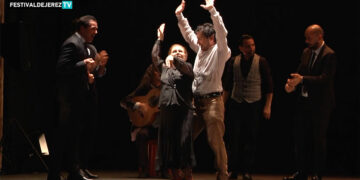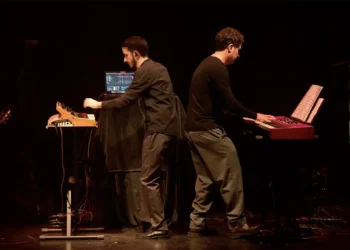|
XV FESTIVAL DE JEREZ |
|
Photos: Ana Palma “EN LA HORMA DE SUS ZAPATOS” Texto: Manuel Moraga NOT FOR SHOWING OFF Dance: Isabel Bayón; Cante: David Lagos, Miguel Ángel Soto “Londro”; Guitar: Jesús Torres, Juan Antonio Suárez “Cano”; Percusion: José Carrasco. A good idea, an efficient structure and brilliant execution were the keys to the success of Isabel Bayón at the Villamarta Theater. The Seville dancer proved you don’t need to spend a lot of money or have a fancy story to put on a well-rounded, coherent dance show. All you need is creativity…and dancing, of course.
Isabel Bayón mounted a tribute to her maestros, María Maya, Matilde Coral and Chano Lobato. If up to this point in the show, Isabel Bayón had taken on music and styles more or less free-form with respect to the classic structures of flamenco, starting from the tangos, everything is in the flamenco line, and everything with the creative touch characteristic of the dancer and her musicians. The tangos were excellent. It’s been a long time since I’ve seen anyone dance like that. And on the same level was her original serrana, interpreted with a retro feel: liviana, serrana and – after a wonderful musical transition – abandolao. I don’t think I’ve ever seen this danced before, and Bayón did a great job. And the same goes for garrotín. Very moving was the tribute to Mario Maya, who taught so many people, including of course, Isabel Bayón herself. I don’t think in the history of flamenco dance there has ever been a maestro who yielded such good fruit as Mario Maya. The list would be interminable, and among those students, without a doubt, the Isabel Bayón we saw yesterday, who dedicated cantiñas to her maestro, as she did with Chano and Matilde. It’s a gesture that does the dancer proud. And the off-stage voices of these people made their absence all the more poignant. Two absences which, unfortunately, are irreparable. Isabel Bayón managed all this with good criteria and sensitivity, organizing everything in a structure that progressed adequately in the artistic sense and the emotional one, and there was never a dull moment. Another virtue: the right amount, so that every spectator was satisfied, but was left wanting more, this was one of the keys to the success of the show. Everyone in the theater had a fine time with Isabel Bayón and her company, because we also have to point out the work of the singers, the wardrobe, lighting, sound, composition and choreography, all important elements. Mario Maya always used to say that Curro Romero’s bullfighting, or Rafael de Paula’s looked easy…”But just you go down there in the ring and do it yourself!” he would always add. Art is about making hard things easy. In this sense, one of the off-stage voices Isabel used, and which makes a good way to sum up the show, was Mario Maya saying: “technique isn’t for showing-off”. ANDRÉS PEÑA “CALLEJÓN DE ASTA” Text: Estela Zatania Andrés Peña’s career has not been meteoric like that of other current dance stars. Nor does his name have that sparkle that makes it a household word, nor do people line up just to get into the theater and breathe the same air as him. Andrés Peña doesn’t pop up in the gossip magazines or the TV talk shows. However, he is one of the biggest talents of flamenco dance to come out of Jerez, a city usually short on dance. This year Peña presented his show “Callejón de Asta – the title refers to the street where he was born and discovered flamenco – at the Sala Compañía, with two performances, last night’s with a full house. Which makes you wonder why this work was not granted the Villamarta Theater where two years ago Peña, along with Pilar Ogalla, presented “Cádiz de la Frontera”, one of the high points of that year’s Festival de Jerez. Makes no difference. Andrés Peña follows his path with resolution and decision, qualities also expressed in his dancing. He is a compact package of elegance, the beauty of power under control. Intelligent subtlety of movement contrasts with the most dynamic moments when you feel the full force of flamenco, a dimension not always present in current dance which dresses up as contemporary and loses specific gravity in the process. The setting is a little hole-in-the-wall dive, and the sound of seagulls tells us we are near the sea (in Jerez, just a few kilometers from the coast, we hear seagulls). Andrés starts out alone, without guitar, backed up by the excellent singing of Manuel Tañé, Luis Moneo and David Palomar, three different voices, each with a recognizable personality. The absence of guitar always adds weight, in this case, well complemented by Andrés’ dense dancing that revels in the basic thrust of four-quarter time, so different from twelve-beat measures. Following this, there was a farruca duet, not something you see every day. In fact, Andrés Peña and Pilar Ogalla are the dancers who best defend the little-used format of couple dancing in flamenco that was so popular years ago (Antonio and Rosario, Gades and Hoyos among so many others). For the farruca, both are wearing jeans and a vest, it all makes a pretty picture of precision and communication between the two, and the sound of Ale Romero’s accordion lends a certain feel of Argentine tango, although the choreography is rigorously flamenco. The warm rich voice of Luis Moneo puts us in the right place for soleá, and Andrés appears with feline intensity, slower than time itself, and more “dangerous”. Clutching the edge of his jacket with a tightly closed fist, his center of gravity is firmly anchored, and he delivers the impact of his original moves. Pilar, wielding a fan and dressed in a pink bata de cola and sassy cap to match, is delightful in 4×4 time with accordion. For the last dance, guitarist Ricardo Rivera lets rip a gust of alegrías cantinas, and the air suddenly smells of salt spray. Palomar sings, and Andrés comes on strong and inspired, with all the flavour and contained force he dominates and administers so well.
|




 In the first part, Isabel Bayón takes on poetry in a variety of ways. The challenge here was to achieve involvement in the poem, the music and the dancing. She definitely managed this and, as we said, via a diversity of musical structures, and in this department she had the professionalism and talent of two fine musicians, Jesús Torres and Juan Antonio Suárez “Cano”. Isabel Bayón – who spent nearly the entire show on stage – gave a lesson in how to use the body as a means of expression: with just arms, without arms, shoulders, waist, hands, head, a glance…everything. And just when this first part seems to drag on a little too long – that’s the danger of being on stage such a long time – it was the second part.
In the first part, Isabel Bayón takes on poetry in a variety of ways. The challenge here was to achieve involvement in the poem, the music and the dancing. She definitely managed this and, as we said, via a diversity of musical structures, and in this department she had the professionalism and talent of two fine musicians, Jesús Torres and Juan Antonio Suárez “Cano”. Isabel Bayón – who spent nearly the entire show on stage – gave a lesson in how to use the body as a means of expression: with just arms, without arms, shoulders, waist, hands, head, a glance…everything. And just when this first part seems to drag on a little too long – that’s the danger of being on stage such a long time – it was the second part.




















